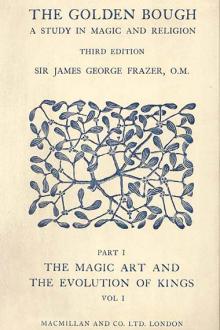The Golden Bough by Sir James George Frazer (ebook reader online free txt) 📕

In antiquity this sylvan landscape was the scene of a strange and recurring tragedy. On the northern shore of the lake, right under the precipitous cliffs on which the modern village of Nemi is perched, stood the sacred grove and sanctuary of Diana Nemorensis, or Diana of the Wood. The lake and the grove were sometimes known as the lake and grove of Aricia. But the town of Aricia (the modern La Riccia) was situated about three miles off, at the foot of the Alban Mount, and separated by a steep descent from the lake, which lies in a small crater-like hollow on the mountain side. In this sacred grove
Read free book «The Golden Bough by Sir James George Frazer (ebook reader online free txt) 📕» - read online or download for free at americanlibrarybooks.com
- Author: Sir James George Frazer
- Performer: -
Read book online «The Golden Bough by Sir James George Frazer (ebook reader online free txt) 📕». Author - Sir James George Frazer
As some people think they can light up the sun or speed him on his way, so others fancy they can retard or stop him. In a pass of the Peruvian Andes stand two ruined towers on opposite hills. Iron hooks are clamped into their walls for the purpose of stretching a net from one tower to the other. The net is intended to catch the sun.
Stories of men who have caught the sun in a noose are widely spread.
When the sun is going southward in the autumn, and sinking lower and lower in the Arctic sky, the Esquimaux of Iglulik play the game of cat’s cradle in order to catch him in the meshes of the string and so prevent his disappearance. On the contrary, when the sun is moving northward in the spring, they play the game of cup-and-ball to hasten his return. When an Australian blackfellow wishes to stay the sun from going down till he gets home, he puts a sod in the fork of a tree, exactly facing the setting sun. On the other hand, to make it go down faster, the Australians throw sand into the air and blow with their mouths towards the sun, perhaps to waft the lingering orb westward and bury it under the sands into which it appears to sink at night.
As some people imagine they can hasten the sun, so others fancy they can jog the tardy moon. The natives of New Guinea reckon months by the moon, and some of them have been known to throw stones and spears at the moon, in order to accelerate its progress and so to hasten the return of their friends, who were away from home for twelve months working on a tobacco plantation. The Malays think that a bright glow at sunset may throw a weak person into a fever. Hence they attempt to extinguish the glow by spitting out water and throwing ashes at it. The Shuswap Indians believe that they can bring on cold weather by burning the wood of a tree that has been struck by lightning. The belief may be based on the observation that in their country cold follows a thunderstorm. Hence in spring, when these Indians are travelling over the snow on high ground, they burn splinters of such wood in the fire in order that the crust of the snow may not melt.
4. The Magical Control of the WindONCE more, the savage thinks he can make the wind to blow or to be still. When the day is hot and a Yakut has a long way to go, he takes a stone which he has chanced to find in an animal or fish, winds a horse-hair several times round it, and ties it to a stick.
He then waves the stick about, uttering a spell. Soon a cool breeze begins to blow. In order to procure a cool wind for nine days the stone should first be dipped in the blood of a bird or beast and then presented to the sun, while the sorcerer makes three turns contrary to the course of the luminary. If a Hottentot desires the wind to drop, he takes one of his fattest skins and hangs it on the end of a pole, in the belief that by blowing the skin down the wind will lose all its force and must itself fall. Fuegian wizards throw shells against the wind to make it drop. The natives of the island of Bibili, off New Guinea, are reputed to make wind by blowing with their mouths. In stormy weather the Bogadjim people say, “The Bibili folk are at it again, blowing away.” Another way of making wind which is practised in New Guinea is to strike a “wind-stone” lightly with a stick; to strike it hard would bring on a hurricane. So in Scotland witches used to raise the wind by dipping a rag in water and beating it thrice on a stone, saying: “I knok this rag upone this stane
To raise the wind in the divellis name, It sall not lye till I please againe.”
In Greenland a woman in childbed and for some time after delivery is supposed to possess the power of laying a storm. She has only to go out of doors, fill her mouth with air, and coming back into the house blow it out again. In antiquity there was a family at Corinth which enjoyed the reputation of being able to still the raging wind; but we do not know in what manner its members exercised a useful function, which probably earned for them a more solid recompense than mere repute among the seafaring population of the isthmus. Even in Christian times, under the reign of Constantine, a certain Sopater suffered death at Constantinople on a charge of binding the winds by magic, because it happened that the corn-ships of Egypt and Syria were detained afar off by calms or head-winds, to the rage and disappointment of the hungry Byzantine rabble. Finnish wizards used to sell wind to storm-stayed mariners. The wind was enclosed in three knots; if they undid the first knot, a moderate wind sprang up; if the second, it blew half a gale; if the third, a hurricane.
Indeed the Esthonians, whose country is divided from Finland only by an arm of the sea, still believe in the magical powers of their northern neighbours. The bitter winds that blow in spring from the north and north-east, bringing ague and rheumatic inflammations in their train, are set down by the simple Esthonian peasantry to the machinations of the Finnish wizards and witches. In particular they regard with special dread three days in spring to which they give the name of Days of the Cross; one of them falls on the Eve of Ascension Day. The people in the neighbourhood of Fellin fear to go out on these days lest the cruel winds from Lappland should smite them dead. A popular Esthonian song runs: Wind of the Cross! rushing and mighty!
Heavy the blow of thy wings sweeping past!
Wild wailing wind of misfortune and sorrow, Wizards of Finland ride by on the blast.
It is said, too, that sailors, beating up against the wind in the Gulf of Finland, sometimes see a strange sail heave in sight astern and overhaul them hand over hand. On she comes with a cloud of canvas—all her studding-sails out—right in the teeth of the wind, forging her way through the foaming billows, dashing back the spray in sheets from her cutwater, every sail swollen to bursting, every rope strained to cracking. Then the sailors know that she hails from Finland.
The art of tying up the wind in three knots, so that the more knots are loosed the stronger will blow the wind, has been attributed to wizards in Lappland and to witches in Shetland, Lewis, and the Isle of Man. Shetland seamen still buy winds in the shape of knotted handkerchiefs or threads from old women who claim to rule the storms. There are said to be ancient crones in Lerwick now who live by selling wind. Ulysses received the winds in a leathern bag from Aeolus, King of the Winds. The Motumotu in New Guinea think that storms are sent by an Oiabu sorcerer; for each wind he has a bamboo which he opens at pleasure. On the top of Mount Agu in Togo, a district of West Africa, resides a fetish called Bagba, who is supposed to control the wind and the rain. His priest is said to keep the winds shut up in great pots.
Often the stormy wind is regarded as an evil being who may be intimidated, driven away, or killed. When storms and bad weather have lasted long and food is scarce with the Central Esquimaux, they endeavour to conjure the tempest by making a long whip of seaweed, armed with which they go down to the beach and strike out in the direction of the wind, crying “Taba (it is enough)!” Once when north-westerly winds had kept the ice long on the coast and food was becoming scarce, the Esquimaux performed a ceremony to make a calm.
A fire was kindled on the shore, and the men gathered round it and chanted. An old man then stepped up to the fire and in a coaxing voice invited the demon of the wind to come under the fire and warm himself. When he was supposed to have arrived, a vessel of water, to which each man present had contributed, was thrown on the flames by an old man, and immediately a flight of arrows sped towards the spot where the fire had been. They thought that the demon would not stay where he had been so badly treated. To complete the effect, guns were discharged in various directions, and the captain of a European vessel was invited to fire on the wind with cannon. On the twenty-first of February 1883 a similar ceremony was performed by the Esquimaux of Point Barrow, Alaska, with the intention of killing the spirit of the wind. Women drove the demon from their houses with clubs and knives, with which they made passes in the air; and the men, gathering round a fire, shot him with their rifles and crushed him under a heavy stone the moment that steam rose in a cloud from the smouldering embers, on which a tub of water had just been thrown.
The Lengua Indians of the Gran Chaco ascribe the rush of a whirlwind to the passage of a spirit and they fling sticks at it to frighten it away. When the wind blows down their huts, the Payaguas of South America snatch up firebrands and run against the wind, menacing it with the blazing brands, while others beat the air with their fists to frighten the storm. When the Guaycurus are threatened by a severe storm, the men go out armed, and the women and children scream their loudest to intimidate the demon. During a tempest the inhabitants of a Batak village in Sumatra have been seen to rush from their houses armed with sword and lance. The rajah placed himself at their head, and with shouts and yells they hewed and hacked at the invisible foe. An old woman was observed to be specially active in the defence of her house, slashing the air right and left with a long sabre. In a violent thunderstorm, the peals sounding very near, the Kayans of Borneo have been seen to draw their swords threateningly half out of their scabbards, as if to frighten away the demons of the storm. In Australia the huge columns of red sand that move rapidly across a desert tract are thought by the natives to be spirits passing along. Once an athletic young black ran after one of these moving columns to kill it with boomerangs. He was away two or three hours, and came





Comments (0)